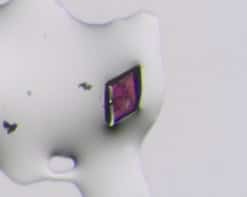
Lasers that should be scalable to arbitrarily high powers while retaining their frequency purity have been produced by researchers in the US. Their invention, which relies on an analogue to the physics of electrons in a Dirac semiconductor such as graphene, solves a problem dating back to the invention of the laser. The researchers believe their work could also inspire fundamental theoretical discoveries in quantum mechanics at macroscopic scales.
Any laser fundamentally comprises two essential components: a cavity and a gain medium – usually a semiconductor, explains Boubacar Kanté of University of California, Berkeley – the senior author of a paper that will appear in Nature describing the lasers. “The semiconductor emits a broad range of frequencies, and the cavity selects what frequency will be amplified to reach the lasing threshold.”
The problem is that any cavity will support not just a ground state “fundamental” frequency of a laser, but also several higher-frequency excited states. Pumping the cavity harder to boost the power of the laser inevitably tends to excite these higher-frequency states towards the lasing threshold. Higher-power lasers need larger cavities, but these support a denser spectrum of frequencies.
Nobody knew what to do about it
“If the gain only overlaps with the fundamental, then only the fundamental will lase, and people make nanolasers all the time with no problem,” says Kanté. “But if the higher-order mode comes close, you cannot distinguish between the two and they will both lase. This is a six decade-old problem: everybody knows it, and nobody knows what to do about it.”
Until now, that is. If the fundamental cavity mode were able to absorb all the energy from the gain medium, the researchers reasoned, all the higher order modes would be suppressed. The problem in a conventional laser cavity is that the ground state wavefunction is at its maximum in the centre of the cavity and falls to zero towards the edges. “In any surface emitting laser, or any cavity that we know to date…there is no lasing [at the fundamental frequency] from the edge,” explains Kanté; “If there is no lasing from the edge, you have a lot of gain available there. And because of that the second-order mode lives at the edge, and very soon the laser becomes multimode.”
To get around this problem, Kanté and colleagues utilized photonic crystals. These are periodic structures, which, like electronic semiconductors, have “band gaps” – frequencies at which they are opaque. Like graphene in electronics, photonic crystals generally contain Dirac cones in their band structures. At the vertex of such a cone is the Dirac point, where the band gap closes.
Hexagonal photonic crystal
The researchers designed a laser cavity containing a hexagonal photonic crystal lattice that was open at the edges, allowing photons to leak into the space around the crystal, meaning that the wavefunction was not confined to be zero at its edge. The photonic crystal had a Dirac point at zero momentum. As momentum is proportional to wave vector, the in-plane wave vector was therefore zero. This means that the cavity did indeed support a mode that was single valued all over the lattice. Provided the cavity was pumped at the energy of this mode, no energy ever went into any other mode, no matter how large the cavity. “The photon has no in-plane momentum, so the only thing left is for it to escape vertically,” explains Kanté.
The researchers fabricated cavities comprising 19, 35 and 51 holes: “When you are not pumping at the Dirac frequency singularity you see lasing at multiple peaks,” says Kanté. “At the Dirac singularity, it never becomes multimode. The flat mode removes gain for the higher order modes.” Theoretical modelling suggests that the design should work even for cavities containing millions of holes.

Topological source emits light with high and multiple orbital angular momenta
In future, Kanté believes that the concepts developed by his team could have implications in electronics itself, and to the scalability of quantum mechanics to the macroscopic world more generally. “All the challenge in quantum science is scaling,” he says. “People are working on superconducting qubits, trapped atoms, defects in crystals…the only thing they want to do is scale. My claim is that it’s to do with the fundamental nature of the Schrödinger equation: when the system is closed, it doesn’t scale; if you want the system to scale, the system needs to have loss,” he says.
Liang Feng of the University of Pennsylvania adds, “The single-mode broad-area laser is one of the holy grails actively pursued by the semiconductor laser community, and scalability is the most critical merit”. “[Kanté’s work] demonstrates just what people are looking for, and it demonstrates exceptional scalability backed by excellent experimental results. Obviously more work needs to be done to transform this strategy, demonstrated in optically pumped lasers, into viable electrically injected diode lasers, but we can expect that this work will inspire a new generation of high-performance lasers that can benefit multiple game-changing industries like virtual and augmented reality systems, LiDARs, defence and so many others where lasers play critical roles.”
The team has dubbed its device the Berkeley Surface Emitting Laser (BerkSEL) and describe it in an unedited preview version of their paper that is currently available on the Nature website.



